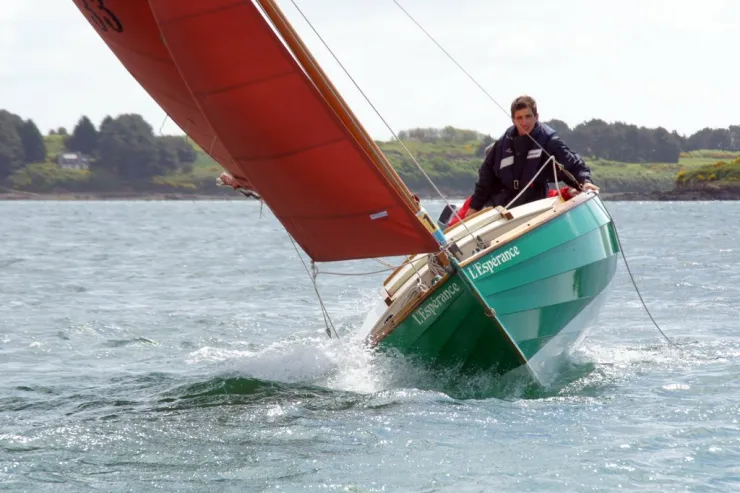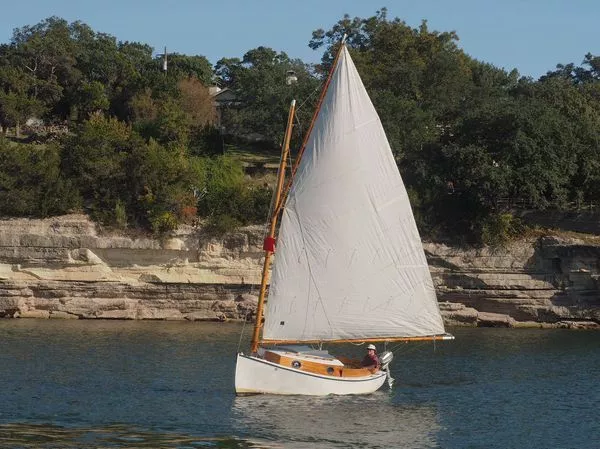
We manufacture Sailing Boat for Sale USA and Canada. Check our website for more information about sailboats, motorboats and sailing yachts for sale
To take a boat upwind is the most demanding task for the sailor. In a race, this is the leg where the good sailors will most easily move past the beginners. We already know we cannot sail closer than 45◦ to the wind direction, so if our destination is somewhere upwind, we must sail close hauled on one tack then come about and continue close hauled on the new
tack.
Sailing close hauled is different from all other points of sailing because the sail is set at a particular place over the boat and the whole boat is moved toward or away from the wind to keep the sail on the verge of luffing. For the Tech, the end of the boom should be kept over the stern corner, perhaps where one end of the traveler line comes through the stern
deck.
The Wind for the Boat for Sale USA

If the wind is very light, it will be better to keep the boom further outboard of this point, and if the wind is stronger, the boom can be trimmed inboard of this point if you can hike the boat down and keep it from heeling excessively to leeward. For any given wind strength, it is while close-hauled that you will tip the most. Learn how to hook a toe under
the thwart seat so you can hike (lean out) and apply some leverage to hold the boat down. Perhaps now is the time to start using the tiller
extension so you can get your weight over the side and still keep the tiller near the centerline of the boat.
The tiller extension is not recommended for your early sails because it can get caught in various places and interfere with your steering. However, once mastered, the tiller extension is a valuable tool and essential in boats like the Larks and Lasers used at MIT.
In a puff, it may be necessary to spill some wind by easing out the sail to avoid excessive heel or weather helm. Once the puff has passed, or you have moved your weight windward to offset the force of the wind,
the sail must come back in if you expect to sail your highest possible course at maximum speed.
Furthermore, the luff of the sail must be watched about 90 percent of the time and the tiller kept in constant but gentle movement as you seek the optimal course. You will soon learn that minute changes of course as well as minute changes in sail trim (even as little as 1 inch) can be major factors in performance.
In irons or in stays is the condition where a boat is luffing in the wind without forward motion and, therefore, without the ability to steer or without steerage way. To get a boat out of irons, push the tiller toward the side in which you want the bow to turn and wait for the boat to make sternway, then steer the boat out to a course where the sail can be trimmed. Sternway can also be started by holding the boom out over the side into the wind.
You can also use the rudder as a paddle to give you headway by making quick movements to one side or by a combination of both. It should be evident that forward or backward movement of the boat is necessary to get a response from the rudder
When the Tech is at the front of the dock, it should be headed along the dock in the direction that allows the bow to be pointed closest into the wind and with the sail luffing. To get away from the dock, check the wind to see where you must head to be able to fill the sail, and determine what will be the windward side so you will know where to sit. Get the boat
moving along the dock so the tiller will work and steer onto the course you have determined is necessary to fill your sail.
You can start by sitting in the boat and pulling yourself along to get some speed while you steer away with the other hand, or you can stand on the dock holding the stay, take a few steps along the dock to develop speed, giving one final push out as you step into the departing boat. As you might imagine, the latter method takes a little more agility and understanding of the hull’s stability. Keep your sail luffing until the momentum of your push carries the boat to a course that will allow the sail to seek the leeward side.
To make a landing, you must again carefully check the wind on the club’s flag to determine which direction is most upwind. Approach the leeward side of the spot you expect to land in so you will have room to turn up into your spot. Since you have no brakes, you must be prepared to luff your sail to slow down.
If you misjudge when to let out the sail and let it out too soon (and lose your headway before your destination is realized), you will lose the ability to steer. Try to touch the dock with the part of your hull where the stay goes through the gunwale, and as soon as you touch, move the tiller away from the dock to increase the friction and thus stop the boat quicker.
A final word of advice avoid the tendency of making your turn too early and thus using up all your turning room. Also, in the first few landings,
select a spot with plenty of room on either side on which to land. The hull of the boat has a flat and comparatively wide immersed underbody which requires a retractable blade, called a centerboard, to prevent the boat from sliding sideways and to force the hull to progress forward when wind
pressure is applied through the sails.
This board may be left lowered at all times while learning to sail, however, it is usually retracted partially or wholly when sailing off the wind when racing to reduce the resistance or drag and increase the boat’s speed. The centerboard may also be raised slightly to adjust the balance between sail and underwater shape to make steering easier. The novice should leave the centerboard down until he has mastered more important details of sailing. Raising the centerboard will increase rolling and reduce the boat’s stability.
Larger boats, such as MIT’s Rhodes 19’s, have a fixed keel in place of the centerboard. This heavy keel gives the boat the additional advantage of much more stability and makes it difficult to capsize. It has the disadvantage of making the boats difficult to take out of the water.
The crew should sit forward of the cross seat or thwart but preferably fairly close to it since the weight in the bow or narrow part of the boat
depresses the bow, makes the boat harder to steer, and also allows waves to slap in. If two persons are carried beside the helmsman, they should sit on the floor on either side of the centerboard with their backs resting against the seat.
Their weight will then be in the center of the boat and evenly dispersed. If a single crew is carried in light air, his weight probably
would be best to leeward (the side the sail is carried on), but in a stronger wind he should move across to help keep the boat heeled only slightly to leeward.
The American Bureau of Shipping 1986 published the “Guide for Building and Classing Offshore Racing Yachts” (ABS, 1994) with application to yachts up to 30.5 meters with plan approval. The Guide was updated in 1994 and in 1997 became limited to vessels having an overall length between 24 and 30.5 meters. After 1997 ABS stopped maintaining the Guide. All the main aspects of sailing yacht design are assessed: materials, details and fastenings, plating, internals, rudders, and keels.
The only areas on which no indications are provided are the mast and rigging. Where the hull scantlings are concerned, the Rules in section 7 provide formulae and tables for the thickness calculation of plating; aluminum, steel, fiber-reinforced plastic (both single skin and sandwich) and wood are considered. The same approach is assumed for the scantling of internal reinforcements. Compliance with this standard was required by the International Sailing Federation (ISAF) for yachts entering most offshore sailing races. In 2009 ISAF began requiring compliance with ISO 12215.
For all those aspects not included in the Offshore Racing Yacht Guide, reference should be made to the “Guide for Building and Classing of Motor Pleasure Yachts” (ABS, 2000) for displacement and semi-planing yachts. Designers of large sailing yachts capable of sustaining high speeds (in the planning regime) are referred to the “Guide for Building and Classing High Speed Craft” (ABS, 2001) for appropriate hull plating and internal structure scantlings.
